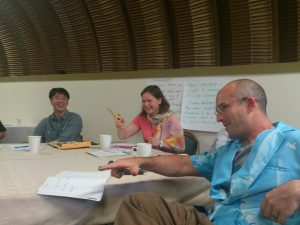At our spring retreat in Hawaii, we were privileged to hear Jim Dator share his insights into governance foresight and policy interfaces. Jim brings a wealth of experience and practical examples of how foresight can be applied across multiple sectors, from his work with American prisons in the 70s, to designing governance systems for Mars. Governance foresight continued as a theme during the retreat, echoing conversations from our SOIF 2013 retreat at Wilton Park which had a focus on anticipatory governance.
At Hawaii, there was both optimism and realism and while it is clear that there are many obstacles to governance foresight, three main obstacles emerged:
- Fear – both a fear of lack of understanding about foresight outcomes and processes leading to inaction,
- Structures – organisations have antiquated governance models unsuited to anticipatory thinking preventing strategic foresight from being implanted, and
- Complexity – concerns that simple solutions just do not exist and that the map is not the territory.
In order to expand the reach and success of foresight in governance, history suggests that there must be a champion. Ideally this would be a senior-level official or bureaucrat who can rally support around a foresight process.
Wider stakeholder engagement is also crucial, with support from 30-40 percent of stakeholders for success. Every process will also have its detractors, and there is likely to be 10 percent who will push back.
 In our view, for success, a foresight process must effectively engage participants and members of an organisation from an early stage and the benefits of the process must be communicated effectively to senior leadership. Input from senior leadership must be though positive forms and insights rather than pedestrian analysis, which can often distract from real insights where it is felt this analysis is a waste of time.
In our view, for success, a foresight process must effectively engage participants and members of an organisation from an early stage and the benefits of the process must be communicated effectively to senior leadership. Input from senior leadership must be though positive forms and insights rather than pedestrian analysis, which can often distract from real insights where it is felt this analysis is a waste of time.
For longer-term success any process must be systematically embedded into an organisation’s culture and engagement across stakeholder groups must be actively maintained throughout.
Further reading
James A. Dator: The Man Who Beats the Drum for Futures Studies. Wendell, B. Journal of Futures Studies, December 2013, 18(2): 105-11 http://www.jfs.tku.edu.tw/18-2/S03.pdf
Leon S. Fuerth with Evan M. H. FaberAnticipatory Governance: Winning the Future http://www.wfs.org/futurist/2013-issues-futurist/july-august-2013-vol-47-no-4/anticipatory-governance-winning-future
